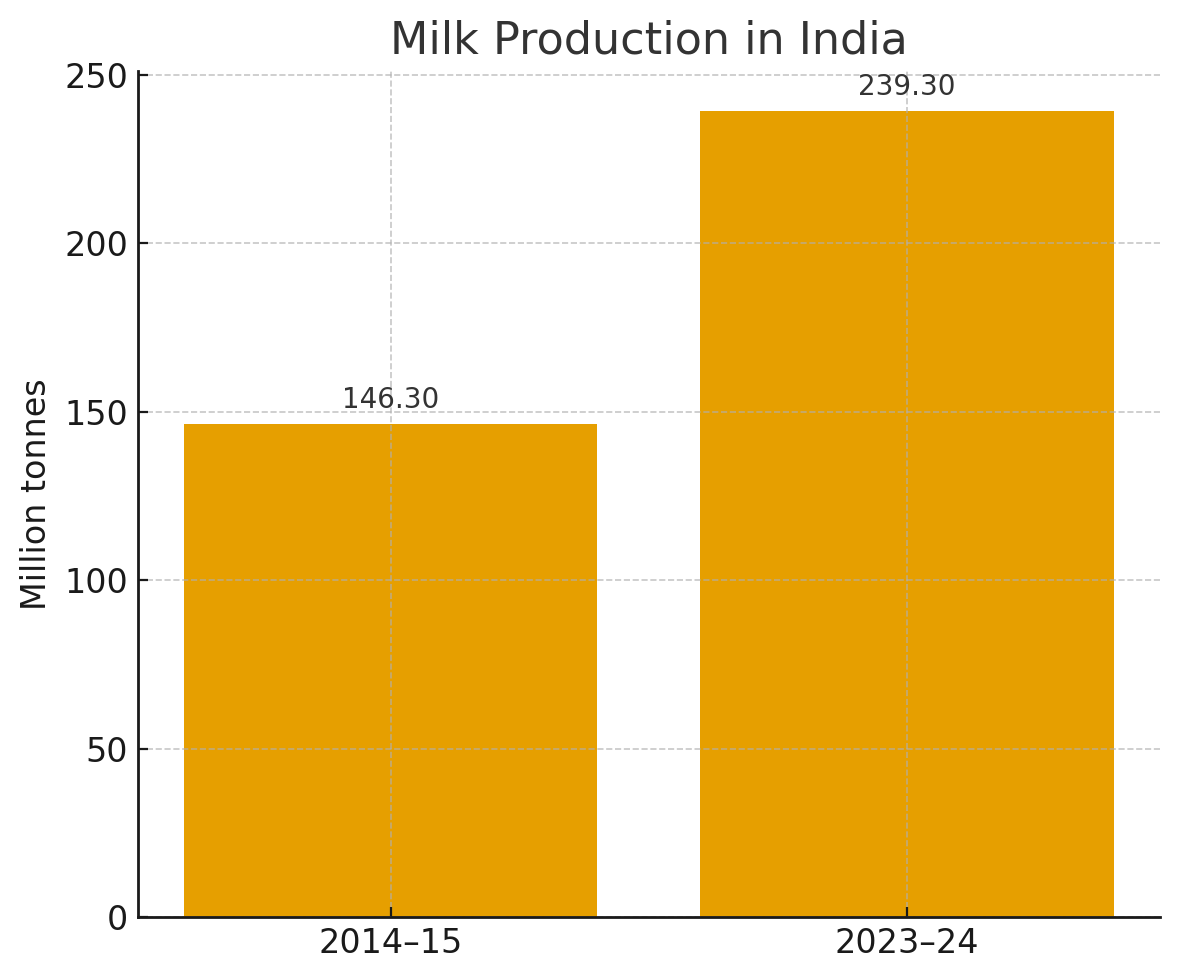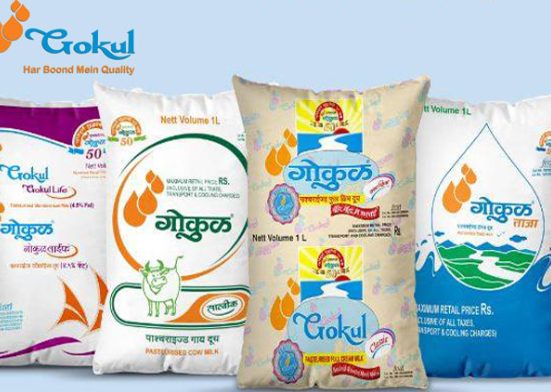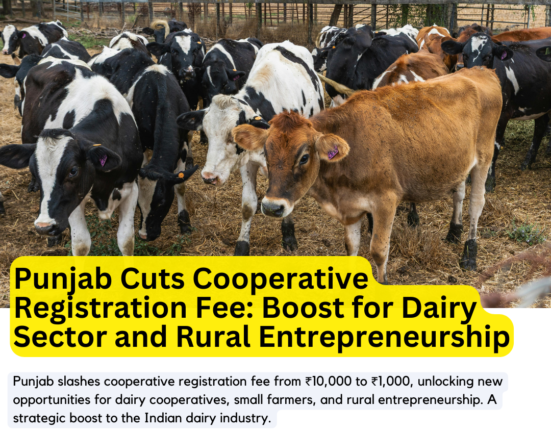India’s dairy industry remains a cornerstone of national nutrition, rural income generation, and economic resilience. As the world’s largest milk producer—contributing nearly 25% of the global milk supply—India has not only expanded production volumes but also achieved impressive gains in per-animal productivity, cooperative and institutional depth. Yet, the next phase of growth depends critically on executing policy reforms at scale, particularly in breeding, infrastructure, traceability, and sustainability.
Unprecedented Growth, Uneven Outcomes
 Milk production in India surged from 146.3 million tonnes in 2014–15 to 239.3 million tonnes in 2023–24, marking a compound annual growth rate (CAGR) of around 5.7%. This has pushed per-capita milk availability to 471 grams per day—well above the global average of approximately 322 grams. Notably, India’s 27.4% increase in bovine productivity over the past decade is the fastest among major dairy-producing nations.
Milk production in India surged from 146.3 million tonnes in 2014–15 to 239.3 million tonnes in 2023–24, marking a compound annual growth rate (CAGR) of around 5.7%. This has pushed per-capita milk availability to 471 grams per day—well above the global average of approximately 322 grams. Notably, India’s 27.4% increase in bovine productivity over the past decade is the fastest among major dairy-producing nations.
However, the impressive growth masks underlying disparities. While Western and Northern states lead in productivity and infrastructure, the Eastern and Northeastern regions continue to lag in both yield and per-capita availability. Addressing this regional imbalance remains a key policy challenge.
What’s Powering the Dairy Engine?
Genetic Gains & Technology Adoption
 India’s aggressive push for genetic upgradation is yielding results. With over 565 lakh artificial inseminations (AI) projected for 2024–25, the use of sex-sorted semen, IVF, and embryo transfer (ET) technologies is accelerating the quality of dairy herds. The revamped Rashtriya Gokul Mission supports this effort by investing in high-quality semen stations, bull mother farms, genomic tools, and scientific rearing of heifers.
India’s aggressive push for genetic upgradation is yielding results. With over 565 lakh artificial inseminations (AI) projected for 2024–25, the use of sex-sorted semen, IVF, and embryo transfer (ET) technologies is accelerating the quality of dairy herds. The revamped Rashtriya Gokul Mission supports this effort by investing in high-quality semen stations, bull mother farms, genomic tools, and scientific rearing of heifers.
Institutional Infrastructure & Cooperative
The dairy cooperative spans 22 state federations and 241 unions, reaching nearly 2.35 lakh villages and over 1.72 crore members. This structure ensures efficient procurement, quality assurance, and the inclusion of farmers. Programmes such as the National Programme for Dairy Development (NPDD), the Dairy Processing and Infrastructure Development Fund (DIDF), and the Animal Husbandry Infrastructure Development Fund (AHIDF) are upgrading village-level chilling units, testing laboratories, and processing facilities.
Women at the Forefront
Nearly 70% of on-farm labour in the dairy sector is performed by women. With more than 48,000 women-led dairy cooperatives participating in Milk Producer Organisations (MPOs), women’s leadership is becoming increasingly central to the sector’s governance and its impact on livelihoods.
White Revolution 2.0: A Blueprint for Transformation
The government’s ambitious five-year plan (2024–29) under White Revolution 2.0 seeks to establish 75,000 new Dairy Cooperatives (DCS) and strengthen over 46,000 existing ones. It also introduces a circular economy focus by encouraging the production of organic manure, biogas units, and sustainable fodder systems.
Bridging the Gaps: Where Policy Must Focus
Despite progress, significant execution gaps persist:
- Low AI Coverage: Only one-third of breedable bovines receive AI, with two-thirds still on natural service, limiting genetic gains.
- Regional Disparities: Eastern and North-Eastern states require tailored interventions, including climate-resilient breeds, regional chilling centres, and fodder corridors.
- Quality and Cold-Chain Deficits: Village-level chilling, testing, and traceability systems need broader and faster deployment.
- Sustainability Concerns: Methane emissions, water-intensive practices, and fodder scarcity present long-term risks.
- Market Volatility: Price shocks, especially during flush-lean cycles and fodder shortages, compress farmer margins and reduce income stability.
Strategic Policy Recommendations for 2025–29
1. Scale Up Artificial Insemination
- Expand AI coverage beyond 50% by 2026, aiming for 70% by 2029.
- Incentivise MAITRI service providers for last-mile coverage.
- Make sex-sorted semen more affordable; expand IVF/ET centres.
- Link state-level incentives to AI coverage and conception rate improvements.
2. Bridge the Regional Divide
- Launch targeted dairy development packages in the East and North-East.
- Mandate regional representation in every NPDD/DIDF project.
- Establish cluster chilling units within a 15 km radius in underserved districts.
3. Make Quality and Traceability the Default
- Equip all milk collection points with real-time SNF/fat/bacterial testing, as well as SMS-based receipts.
- Ensure digital payments on a T+1 basis.
- Scale pilot traceability platforms to a national digital grid to meet domestic quality standards and export protocols.
4. Enable Circular and Climate-Smart Dairying
- Fast-track cooperative units and organic manure hubs.
- Enable monetisation of carbon credits at the society level.
- Promote drought-tolerant fodder, silage systems, ration balancing, and water budgeting through scheme integration.
5. Stabilise Market Risks
- Establish a Milk Price Stabilisation Fund with transparent buffer stock mechanisms (SMP/butter).
- Trigger export incentives when domestic inventories are high.
- Negotiate favourable tariff quotas in FTAs to support dairy exports.
6. Digitise Advisory and Monitoring Systems
- Expand platforms like e-Gopala in all regional languages for farmer advisories.
- Integrate INAPH and cooperative district/state dashboards on AI, disease alerts, and fodder gaps.
Vision 2029: What Success Looks Like
- Over 70% AI coverage and improved conception rates; a sustained rise in female calf births.
- More than 75,000 new cooperatives are operational, ensuring higher procurement with digital traceability.
- Methane emissions per litre are reduced through biogas capture and feed balancing.
- Lot-level traceability standardised across the organised milk sector, enabling high-value domestic and export markets.







